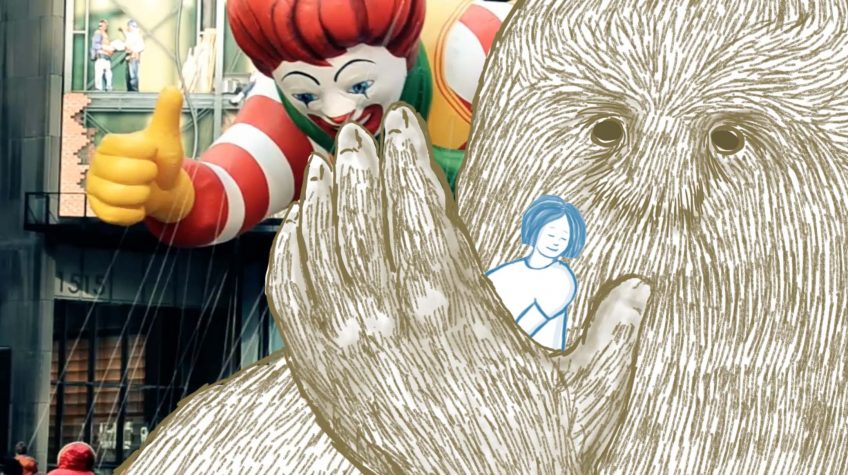FARMINGTON, ME (February 1, 2018) — The University of Maine at Farmington is proud to present “Rough Drafts,” the 2018 UMF Art Faculty Exhibition, which highlights the power of UMF’s diverse artistic voices responding to the contemporary world.
Featured artists include: Ann Bartges,Tom Jessen, Dawn Nye, Elizabeth Olbert, Jesse Potts, Katrazyna Randall and Barbara Sullivan.
This exhibit runs from Thursday Feb. 8, through Friday March 9, in the UMF Art Gallery and the Emery Community Arts Center Flex Gallery. It is free and open to the public with an opening reception from 5-7:30 p.m., Feb. 8.
Ann Bartges’ “Fluoroscope” is a sculptural work that mimics the form of Thomas Edison’s original fluoroscope design. A stop-motion animation plays inside the sculpture, and a life-size print of a woman in a red robe cascades over the outside. Edison’s fluoroscope was an imaging tool that used a continuous x-ray beam, creating a live, continuous view of the inner body. In Bartges’ version, a woman places her hand inside the machine, and the machine reveals a gradual progression through layers of data, appearing, at first, to dive deep inside her skin.
Bartges’ new-media installation, “Siren Song,” is a meditation on video chat. She uses the spacial disconnect and confusion of a moth and light bulb to mirror her relationship with a Skyped-in companion. In her “Zoetrope,” Bartges’ viewer spins the device to animate a strip of sequential photographs. A video camera sends a live feed video of the moving image to a projector. The image is projected at a life-like scale onto screen. When the viewer leaves the zoetrope, the machine comes to a stop, revealing the image as lifeless without an operator.
For the last few years, Tom Jessen has been engaged in a courtship with the router as a drawing device. The physicality of this dance translates to objects that spotlight the tactility of relief in wood. He is fascinated with the oscillation between head and body-knowledge, reference and abstraction, definition and ambiguity. While a gestural application of the router might reference topography, Jessen uses a landscape reference as ballast to ultimately bring the work back to the materials, the process, the artist’s hand and the object. This snapping back and forth between a subtle representation and pure abstraction allows the viewer to determine the work’s interpretation.
In her combined media construction, “Domestic Dule,” Katrazyna Randall conducts a surreal investigation into the imposition of consumer aesthetics on our physical environment through the use of prosaic plastic flora and fauna. She writes, “Nature is plastic. It is plastic space, plastic surfaces and plastic innards. It is wonder, it is heroics, it is religion, it is poetry, prose and purpose. It is culture. It is an amusement park, a glossy brochure, a destination wedding. Landscape painting is mimicry, memory, nostalgia, souvenir and tchotchke. It is forced perspective. It is language applied that obliterates meaning. It is a cacophony of ubiquitous difference. It is violent. I consider myself a Landscape Painter and as such I recognize the absence of nature.”
Dawn Nye’s surreal videos and prints create disorienting, whimsical and disturbing narratives that touch on childhood dreams and nightmares. Her new animation explores the conflict between responsibility and escape. A young girl is rescued by a giant hairy beast that takes her on a tour of distractions. She is comforted to sleep, though the world continues as she drifts away.
Jesse Potts’ sculptures, photos and installation in this show emerge from a meditation on the purpose and meaning of “home” and explore the ways that meaning can shift based on one’s perception of the relative permanence or transience of their “home.” These works were built using objects and materials related to homebuilding, homemaking, and home repair. Each work combines metaphoric objects and symbolic forms to suggest oppositional forces of movement and stability.
Barbara Sullivan, primarily a fresco painter, returns to oils for her “Nasty Maine Women Artists” series. During the presidential debates of 2016, Donald referred to Hillary as a “Nasty Woman.” In response, Sullivan has painted the portraits of more than fifty strong and nasty Maine women artists and writers. Each portrait was painted as she thought about the strength and purpose of each artist, all of whom she knows personally. She thought about their powerful voices and their commitment to their art practices as she painted each of them.
The gallery is located at 246 Main Street in Farmington, behind the UMF Admissions Office. Gallery hours are Tuesday through Sundays from 12 to 4 p.m. and by appointment. For more information or to make an appointment please contact Sarah Maline, UMF Art Gallery director, at maline@maine.edu or 207.778.1062 or visit the website at artgalleryumf.org.
The Emery Community Arts Center, located on Academy Street, is an innovative, experimental venue for the arts in Western Maine. It features an exciting 160-seat multipurpose performance space and a 1,600-square-foot Flex-Space gallery for traditional exhibits, new media and performance art. A dramatic interior corridor offers additional exhibition space and connects the center with the UMF Alumni Theater. For more information, contact Ann Bartges, ECAC director, at ann.bartges@maine.edu.
EDITOR’S NOTE
Image can be found at:
https://www.umf.maine.edu/wp-content/uploads/sites/1/2018/04/RP178-034.jpg
Photo Credit: Submitted image
Photo Caption: Dawn Nye, image from untitled animation 2018


